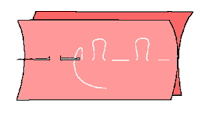Mis alumnas de costura dominan los puntos básicos de costura a mano pero se lían a menudo con su terminología, así que he pensado que os puede ser útil esta pequeña guía.
My sewing pupils master the basic hand sewing stitches but they often get confused with its terminology, so I have thought this guide can be useful for you.

Ensanches o hilván flojo / Tailor tacks: Cuando dibujamos el patrón sobre la tela doble con un jaboncillo sólo tenemos el dibujo del patrón en una de las capas de tela. Para señalarlo en la otra usaremos este punto.
When we draw the pattern on the cloth with a tailor's chalk it's necessary to transfer it onto the other layer of fabric with talilor tacks.
Coseremos con hilo de hilvanar de un color que contraste, doble si se requiere. No se empieza con nudo ni se remata. Las puntadas no deben ser muy grandes y cada dos puntadas, se debe dejar el hilo flojo. Una vez pasados los ensanches por todas las marcas del patrón atravesando ambas capas de tela, separamos las dos telas estirando los hilos y los cortamos por la mitad. De esta forma tenemos el contorno del patrón señalado con hilo en las dos telas y por todas las caras.
Use a thread of soft tacking cotton in a contrasting color to the fabric and double strand of thread if it's necessary. Do not knot the strand and do not sew up. The stitches should be shorts and be sure that the thread every two stitches is left in a long loop. Use tailor’s tacks wherever mark appears on the pattern passing through both layers of fabric. Then open tackings as far as the loose stitches will allow and cut the strands in half so that a tailor’s tack remains on both layers of the material.


Hilván / Basting stitch: El hilván permite unir temporalmente las piezas de tela en su posición hasta que las hayamos cosido definitivamente. También sirve para comprobar la talla y la adecuación del patrón.
Basting is a temporary method for holding your fabric in place until you have sewn your permanent stitching. It also allows you to check the accuracy of fitting a garment or the accuracy of your seams before your final stitching.
Coseremos con hilo de hilvanar con un color que contraste. Atravesamos la tela con la aguja realizando puntadas iguales de aproximadamente 1 cm. separadas a la misma distancia, de manera que quede una línea discontinua.
Use a thread of soft tacking cotton in a contrasting color to the fabric. Weave the needle in and out of the fabric creating the look of a dashed line. Use about ¼" - ½" stitches with equal length spaces between.

Pespunte / Back stitch: Es la puntada que se utiliza habitualmente para hacer las costuras porque quedan muy fuertes. Lo normal es hacerlo a máquina, pero a veces es necesario coser a mano. Se cose de derecha a izquierda. La aguja se clava al final del punto anterior y se saca un poco más adelante. Los puntos deben ser pequeños y regulares.
The backstitch creates a very strong seam. You can certainly use your sewing machine to create a back stitch but sometimes it's necessary to hand sew. Begin at the right end of the opening and work right to left. Pull the needle up through the fabric and do one stitch forward. From underneath, space the needle out the length of your desired stitch, pull up through the fabric, and bring the needle back down through the end of the previous stitch. Make short and equal stitches.

La semana que viene os explico más puntos.
I'll teach you more stitches next week.

